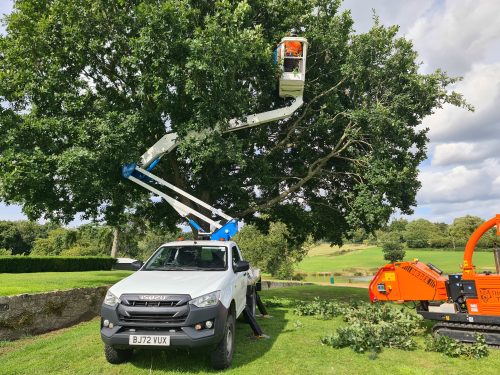 https://www.wilsontreesurgery.com/wp-content/uploads/2024/09/20230807_162313-500x375.jpg
https://www.wilsontreesurgery.com/wp-content/uploads/2024/09/20230807_162313-500x375.jpg
Machinery used in utility arboriculture
Read more
by Wilson Tree Surgery |
Ash dieback threatens one of the most beloved trees in our country – the ash tree. Ash dieback, scientifically known as Hymenoscyphus fraxineus, is a fungal disease that has been quietly wreaking havoc in ash tree populations.
Ash trees have long held a special place in the landscape, valued for their graceful appearance, strong wood, and ecological importance. They can grow up to 35m and are used in all aspects of life, from crafting furniture to providing shelter for countless species of birds and insects. Unfortunately, ash dieback is posing a serious threat to ash trees across the UK.
The most prominent symptoms for affected trees are:
Ash dieback is caused by a fungus known as Hymenoscyphus fraxineus. This pathogen, originally from Asia, was accidentally introduced to Europe, where it quickly spread, causing the widespread decline and death of ash trees. The fungus infects the tree’s leaves and stems, leading to a range of symptoms, from wilting leaves to dieback of branches.
Spread and Impact Ash dieback has spread rapidly, affecting large parts of Europe and North America. The consequences are devastating: damaged ecosystems, economic losses in the timber industry, and the loss of a significant cultural and ecological resource. In the UK alone, it is expected that ash dieback will kill 80% off ash tree, costing billions financially and leading to a huge loss of biodiversity.
Loss of Biodiversity
Ash trees provide habitat and sustenance for many species, including insects, birds, and mammals. The loss of ash trees means the loss of these habitats, which could lead to a decline in biodiversity.
Soil Health
Ash trees play a crucial role in maintaining soil health through their nutrient cycling. Their loss can disrupt the delicate balance of forest ecosystems.
Aesthetic and Cultural Loss
Ash trees are not just trees; they are a part of our history, culture, and landscape. Their decline impacts our aesthetics and the cultural significance they hold in various societies.
While ash dieback is a formidable threat, efforts are underway to mitigate its impact:
Monitoring: Regular monitoring of ash tree populations is essential to detect and manage the spread of the disease.
Research: Scientists are actively working to better understand the disease, identify resistant tree varieties, and develop potential treatments.
Quarantine Measures: Implementing strict controls on the movement of ash tree materials can help prevent the disease’s spread to new areas.
Diversification: Promoting the planting of diverse tree species in woodlands and urban areas can reduce the impact of ash dieback.
Scientists and conservationists are closely monitoring affected areas and conducting research to better understand the disease. This knowledge can inform future management strategies.
If you think you have spotted a tree affected by ash dieback, please report it to Tree Alert.
 https://www.wilsontreesurgery.com/wp-content/uploads/2024/09/20230807_162313-500x375.jpg
https://www.wilsontreesurgery.com/wp-content/uploads/2024/09/20230807_162313-500x375.jpg
Read more
 https://www.wilsontreesurgery.com/wp-content/uploads/2024/09/AdobeStock_475873508-500x333.jpeg
https://www.wilsontreesurgery.com/wp-content/uploads/2024/09/AdobeStock_475873508-500x333.jpeg
Read more
 https://www.wilsontreesurgery.com/wp-content/uploads/2024/09/pexels-valiphotos-589802-500x333.jpg
https://www.wilsontreesurgery.com/wp-content/uploads/2024/09/pexels-valiphotos-589802-500x333.jpg
Read more